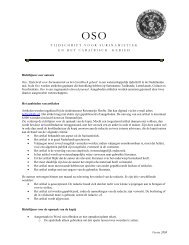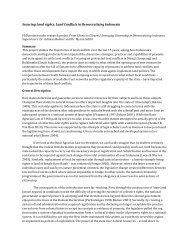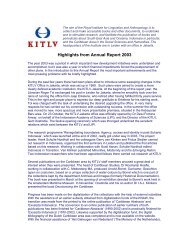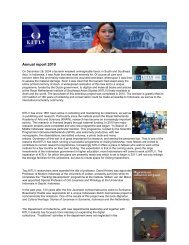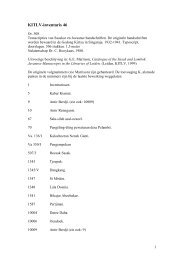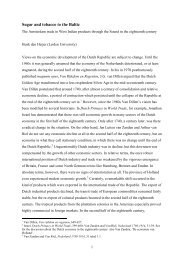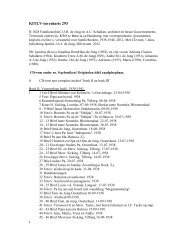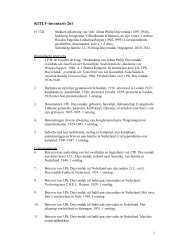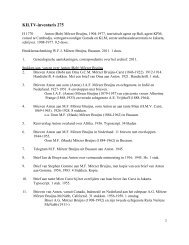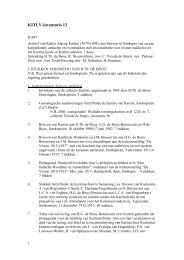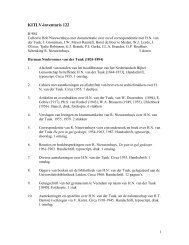The Acehnese past and its present state of study R. Michael ... - kitlv
The Acehnese past and its present state of study R. Michael ... - kitlv
The Acehnese past and its present state of study R. Michael ... - kitlv
You also want an ePaper? Increase the reach of your titles
YUMPU automatically turns print PDFs into web optimized ePapers that Google loves.
Aceh as a fi eld for ancient history studies 27<br />
Six years later, McKinnon, Lukman Nurhakim <strong>of</strong> the Archaeological Research<br />
Centre <strong>of</strong> Indonesia (Pusat Penelitian dan Pengembangan Arkeologi<br />
Nasional), Nurdin A.R. <strong>of</strong> the Aceh Museum <strong>and</strong> Pierre-Yves Manguin <strong>of</strong> the<br />
École Française d’Extrême-Orient, identifi ed several sites in the Krueng Raya<br />
Bay. <strong>The</strong> remains <strong>of</strong> an earthen wall, 3-4 m high, <strong>and</strong> dating to the sixteenth or<br />
the beginning <strong>of</strong> the seventeenth century, were discovered in Lhok Cut, close<br />
to the eastern tip <strong>of</strong> the bay. A layer located at the base <strong>of</strong> this structure yielded<br />
Chinese <strong>and</strong> Southeast Asian ceramic shards dating between the thirteenth<br />
<strong>and</strong> fourteenth centuries, as well as shards <strong>of</strong> Indian red pottery. Moreover,<br />
many fragments <strong>of</strong> gold jewellery were reportedly discovered at this site. <strong>The</strong><br />
remains <strong>of</strong> ancient settlements have also been found in Cut Me <strong>and</strong> Ladong<br />
(McKinnon 1988, 2006a, 2006b). On the opposite side <strong>of</strong> the northern tip <strong>of</strong> the<br />
bay, the remains <strong>of</strong> an old fortress are still visible at Kuta Lubhok. According<br />
to oral tradition, the local population associated this building with the Chola<br />
kings <strong>of</strong> South India (Montana 1997:86).<br />
<strong>The</strong> third area for which the results <strong>of</strong> surveys have been published is<br />
Lhokseumawe. Remains related to the ancient towns <strong>of</strong> Samudra-Pasai have<br />
been found there, where they are still visible among shrimp ponds near the<br />
village <strong>of</strong> Beringin, kecamatan (sub-district) <strong>of</strong> Samudra. Among the fi nds<br />
there are Chinese, Thai <strong>and</strong> Vietnamese ceramics dating between the fi fteenth<br />
<strong>and</strong> the beginning <strong>of</strong> the sixteenth centuries. 3 Several tombstones, which we<br />
will comment on later, confi rm the presence <strong>of</strong> a settlement there since the<br />
fi fteenth century or before. <strong>The</strong>re is also a mound there known as Cut Astana<br />
(Palace Hill). It is approximately 4 m high <strong>and</strong> covers an area <strong>of</strong> about 800m².<br />
This mound appears to shelter a brick structure (Notulen 1884:51). To our<br />
knowledge, the location <strong>of</strong> the older site or sites, known from various sources<br />
<strong>and</strong> settled since the second half <strong>of</strong> the thirteenth century or before, has yet to<br />
be identifi ed.<br />
Without comprehensive archaeological investigations, however, we have<br />
to rely on written sources <strong>and</strong> oral tradition in an attempt to map the ancient<br />
settlements <strong>of</strong> Aceh. By going back in time, starting from the account <strong>of</strong> Tomé<br />
Pires, which dates to the beginning <strong>of</strong> the sixteenth century (Cortesão 1990:135-<br />
48, 163), it is possible to identify the names <strong>of</strong> several coastal settlements<br />
whose foundation occurred in the fi fteenth century or before (Illustration<br />
6). <strong>The</strong>se included Aceh <strong>its</strong>elf, which is mentioned for the fi rst time around<br />
1520. <strong>The</strong> Hikayat Aceh recounts Aceh being founded by the merger <strong>of</strong> two<br />
settlements – Makota Alam <strong>and</strong> Dar ul-Kamal – located on op posite sides <strong>of</strong> a<br />
river (Isk<strong>and</strong>ar 1958:72-5).<br />
3 We would like to thank M.F. Dupoizat for her identifi cation <strong>of</strong> the pictures <strong>of</strong> ceramic shards<br />
collected during a brief survey conducted in Beringin in February 2006 (M.F. Dupoizat, personal<br />
communication, May 2006). <strong>The</strong>se data fi t with those given by McKinnon 2006b:333.




